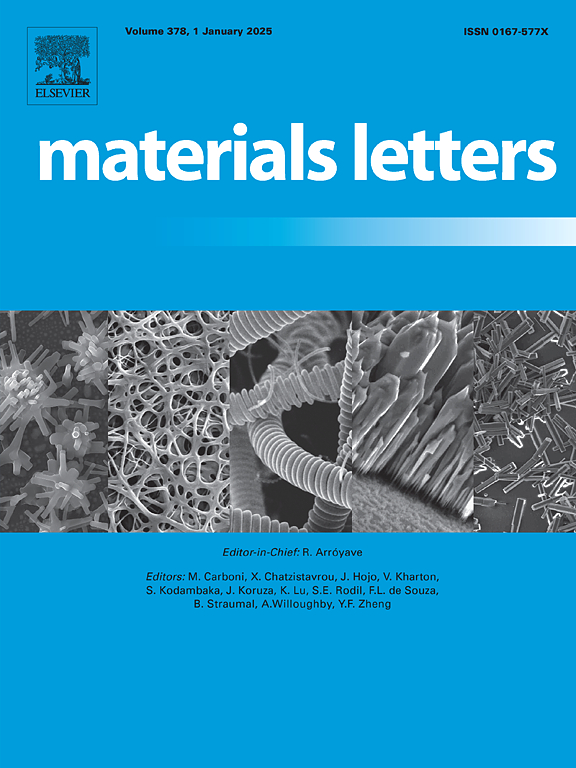表面占主导地位的钠储存技术--用于高性能钠离子电池阳极的二氧化钛纳米片,其(0 0 1)面的暴露率高达 84
IF 2.7
4区 材料科学
Q3 MATERIALS SCIENCE, MULTIDISCIPLINARY
引用次数: 0
摘要
作为钠离子电池(SIB)的阳极材料,无色二氧化钛(TiO2)因其无毒性、优异的结构稳定性和成本效益而备受关注。然而,其固有的低导电性给实际应用带来了巨大挑战。本文研究了超薄二氧化钛纳米片。这种二氧化钛纳米片的厚度为 8 纳米,露出了 84% 的 (0 0 1) 晶面。裸露的(0 0 1)晶面和超薄的纳米片结构为 Na 离子的吸附提供了丰富的活性位点,缩短了离子扩散途径,增强了反应动力学,显著提高了伪电容效应。这种暴露(0 0 1)面与纳米片结构的协同策略使电池在 0.1 A/g 时的容量达到 177.1 mAh/g,在 5 A/g 时的容量保持率为 59%。这项工作将有助于人们理解高性能 SIB 负极材料的面依赖电化学行为。本文章由计算机程序翻译,如有差异,请以英文原文为准。

Surface-dominated sodium storage enabled by TiO2 nanosheets with 84 % exposure of (0 0 1) facets for high-performance Na-ion battery anodes
Anatase titanium dioxide (TiO2) has garnered enormous attention as a promising anode material for sodium-ion batteries (SIBs), owing to its non-toxicity, superior structural stability, and cost-effectiveness. Nevertheless, its intrinsic low electrical conductivity poses a substantial challenge to its practical applications. Here, the ultrathin TiO2 nanosheets were obtained. The TiO2 nanosheets with a thickness of ∼8 nm and exposed 84 % (0 0 1) facet. The exposed (0 0 1) crystal facets and ultrathin nanosheet structure provide abundant active sites for Na-ion adsorption, shortens ion diffusion pathways, enhances reaction kinetics, and significantly boosts the pseudocapacitive effect. This synergistic strategy of exposed (0 0 1) facet with nanosheets structure leads to an exceptional capacity of 177.1 mAh/g at 0.1 A/g, and 59 % capacity retention at 5 A/g. This work will contribute to the understanding of facet-dependent electrochemical behavior anode materials for high-performance SIBs.
求助全文
通过发布文献求助,成功后即可免费获取论文全文。
去求助
来源期刊

Materials Letters
工程技术-材料科学:综合
CiteScore
5.60
自引率
3.30%
发文量
1948
审稿时长
50 days
期刊介绍:
Materials Letters has an open access mirror journal Materials Letters: X, sharing the same aims and scope, editorial team, submission system and rigorous peer review.
Materials Letters is dedicated to publishing novel, cutting edge reports of broad interest to the materials community. The journal provides a forum for materials scientists and engineers, physicists, and chemists to rapidly communicate on the most important topics in the field of materials.
Contributions include, but are not limited to, a variety of topics such as:
• Materials - Metals and alloys, amorphous solids, ceramics, composites, polymers, semiconductors
• Applications - Structural, opto-electronic, magnetic, medical, MEMS, sensors, smart
• Characterization - Analytical, microscopy, scanning probes, nanoscopic, optical, electrical, magnetic, acoustic, spectroscopic, diffraction
• Novel Materials - Micro and nanostructures (nanowires, nanotubes, nanoparticles), nanocomposites, thin films, superlattices, quantum dots.
• Processing - Crystal growth, thin film processing, sol-gel processing, mechanical processing, assembly, nanocrystalline processing.
• Properties - Mechanical, magnetic, optical, electrical, ferroelectric, thermal, interfacial, transport, thermodynamic
• Synthesis - Quenching, solid state, solidification, solution synthesis, vapor deposition, high pressure, explosive
 求助内容:
求助内容: 应助结果提醒方式:
应助结果提醒方式:


